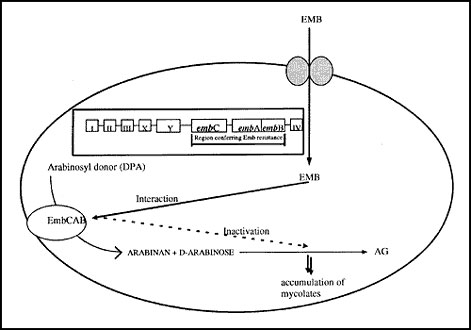Volume 4, Number 2—June 1998
Perspective
Multidrug-Resistant Mycobacterium tuberculosis: Molecular Perspectives
Figure 4

Figure 4. Mechanism of action of ethambutol (adapted from 84-88). EMB interacts with the EmbCAB proteins encoded by the embC, embA, and embB genes, leading to inactivation of arabinogalactan synthesis. Mutations in the embB locus cause alterations in EmbB, possibly leading to an altered target for EMB. Alternatively, hyperexpression of the EmbCAB proteins could lead to EMB resistance. Inlet box: Organization of the emb operon in Mycobacterium tuberculosis (MTB).
Page created: December 14, 2010
Page updated: December 14, 2010
Page reviewed: December 14, 2010
The conclusions, findings, and opinions expressed by authors contributing to this journal do not necessarily reflect the official position of the U.S. Department of Health and Human Services, the Public Health Service, the Centers for Disease Control and Prevention, or the authors' affiliated institutions. Use of trade names is for identification only and does not imply endorsement by any of the groups named above.